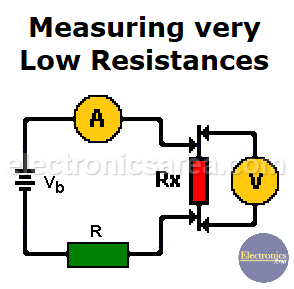Measuring Low Resistances
There are special cases of resistance measurement where the value of the component to be measured is too small and direct measurement with a tester is not practical. In this case, we need a special method for measuring low resistances.
These cases include:
- Measuring the resistance of a track on a printed circuit board.
- Measuring the resistance of a winding (resistance with all the turns of a coil or inductor).
- Measuring the resistance of a fuse.
- Measuring the resistance of a relay.
- Measuring the resistance of a switch.
- Etc.
In this case, we can perform an indirect measurement using of a voltage source, an ammeter and a voltmeter. See the picture below.
Notes:
- An ammeter is a multimeter set to work measuring current.
- A voltmeter is a multimeter set to work measuring voltage.
So we need two multimeters to perform the measurement.
Method for measuring low resistances
We connect the power source Vb and the current limiting resistor R, as shown in the above image. A relatively large current flows through the component to be measured (the track circuit, winding, etc.)
To achieve this, we use a 10V voltage source (Vb), 20 ohms / 10 watts limiting resistor (R) and we connect an ammeter in series with the circuit.
The ammeter shows the current that flow thought the circuit, the voltmeter shows the voltage drop across the component and using the Ohm’s law, we obtain the component resistance value (Rx). Rx = Vx/I.
For example:
See the diagram above.
– If the current value measured with the ammeter is 450 mA and the voltage measured across the component is 10 mV, then the resistance of the component is: Rx = 10 mV/450 mA = 0.0222 ohms or 22.2 milliohms.
– If the current value measured with the ammeter is 720 mA and the voltage measured across the component is 12 mV, then the resistance of the component is: Rx = 12 mV/720 mA = 0.0167 ohms or 16.7 milliohms.
– If the current value measured with the ammeter is 1 A (1000 mA) and the voltage measured across the component is 5 mV, then the resistance of the component is: Rx = 5 mV/1000 mA = 0.005 ohms or 5 milliohms.
Important Note: This measurement method gives very low resistance values. Make sure the tips to be used with the voltmeter have a very low resistance.
More Instruments & Measurements Tutorials
- Multimeter - VOM - Tester
- Measuring resistance with an analog multimeter
- Low resistance measurement
- Measuring the resistance of sensitive components
- What is a Wheatstone bridge circuit?
- How to extend analog multimeter voltage range?
- Testing diodes and transistors with a multimeter
- What is a logic probe?
- Scientific Notation - Engineering Notation
- kWh - cost of electrical energy
- DIY circuit diagrams for test equipment





